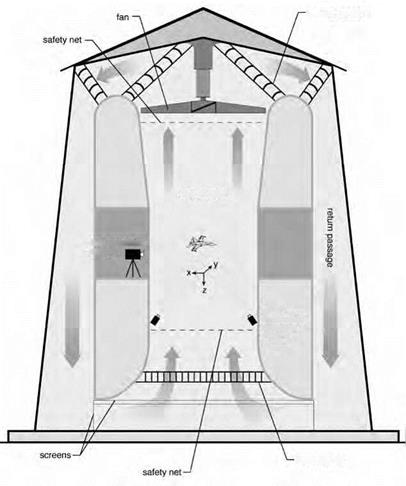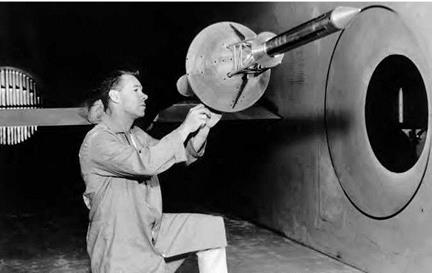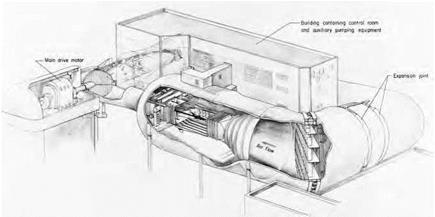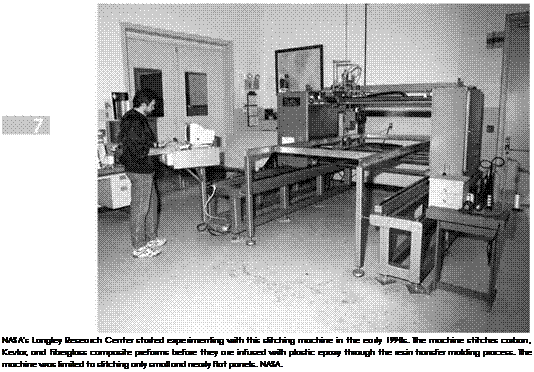NASA’s wind shear research effort involved complex, cooperative relationships between the FAA, industry manufacturers, and several NASA Langley directorates, with significant political oversight, scrutiny, and public interest. It faced many significant technical challenges, not the least of which were potentially dangerous flight tests and evaluations.[91] Yet, during a 7-year effort, NASA, along with industry technicians and researchers, had risen to the challenge. Like many classic NACA research projects, it was tightly focused and mission-oriented, taking "a proven,
significant threat to aviation and air transportation and [developing] new technology that could defeat it.”[92] It drew on technical capabilities and expertise from across the Agency—in meteorology, flight systems, aeronautics, engineering, and electronics—and from researchers in industry, academia, and agencies such as the National Center for Atmospheric Research. This collaborative effort spawned several important breakthroughs and discoveries, particularly the derivation of the F-Factor and the invention of Langley’s forward-looking Doppler microwave radar wind shear detector. As a result of this Government-industry-academic partnership, the risk of microburst wind shear could at last be mitigated.[93]
 In 1992, the NASA-FAA Airborne Windshear Research Program was nominated for the Robert J. Collier Trophy, aviation’s most prestigious honor. Industry evaluations described the project as "the perfect role for NASA in support of national needs” and "NASA at its best.” Langley’s Jeremiah Creedon said, "we might get that good again, but we can’t get any better.”[94] In any other year, the program might easily have won, but it was the NASA-FAA team’s ill luck to be competing that year with the revolutionary Global Positioning System, which had proven its value in spectacular fashion during the Gulf War of 1991. Not surprisingly, then, it was GPS, not the wind shear program, which was awarded the Collier Trophy. But if the wind shear team members lost their shot at this prestigious award, they could nevertheless take satisfaction in knowing that together, their agencies had developed and demonstrated a "technology base” enabling the manufacture of many subsequent wind shear detection and prediction systems, to the safety and undoubted benefit of the traveling public, and airmen everywhere.[95]
In 1992, the NASA-FAA Airborne Windshear Research Program was nominated for the Robert J. Collier Trophy, aviation’s most prestigious honor. Industry evaluations described the project as "the perfect role for NASA in support of national needs” and "NASA at its best.” Langley’s Jeremiah Creedon said, "we might get that good again, but we can’t get any better.”[94] In any other year, the program might easily have won, but it was the NASA-FAA team’s ill luck to be competing that year with the revolutionary Global Positioning System, which had proven its value in spectacular fashion during the Gulf War of 1991. Not surprisingly, then, it was GPS, not the wind shear program, which was awarded the Collier Trophy. But if the wind shear team members lost their shot at this prestigious award, they could nevertheless take satisfaction in knowing that together, their agencies had developed and demonstrated a "technology base” enabling the manufacture of many subsequent wind shear detection and prediction systems, to the safety and undoubted benefit of the traveling public, and airmen everywhere.[95]
NASA engineers had coordinated their research with commercial manufacturers from the start of wind shear research and detector development, so its subsequent transfer to the private sector occurred quickly and effectively. Annual conferences hosted jointly by NASA Langley and the FAA during the project’s evolution provided a ready forum for manufacturers to review new technology and for NASA researchers to obtain a better understanding of the issues that manufacturers were
encountering as they developed airborne equipment to meet FAA certification requirements. The fifth and final combined manufacturers’ and technologists’ airborne wind shear conference was held at NASA Langley on September 28-30, 1993, marking an end to what NASA and the FAA jointly recognized as "the highly successful wind shear experiments conducted by government, academic institutions, and industry.” From this point onward, emphasis would shift to certification, regulation, and implementation as the technology transitioned into commercial service.[96] There were some minor issues among NASA, the airlines, and plane manufacturers about how to calibrate and where to place the various components of the system for maximum effectiveness. Sometimes, the airlines would begin testing installed systems before NASA finished its testing. Airline representatives said that they were pleased with the system, but they noted that their pilots were highly trained professionals who, historically, had often avoided wind shear on their own. Pilots, who of course had direct control over plane performance, wished to have detailed information about the system’s technical components. Airline representatives debated the necessity of considering the performance specifications of particular aircraft when installing the airborne system but ultimately went with a single Doppler radar system that could work with all passenger airliners.[97] Through all this, Langley researchers worked with the FAA and industry to develop certification standards for the wind shear sensors. These standards involved the wind shear hazard, the cockpit interface, alerts given to flight crews, and sensor performance levels. NASA research, as it had in other aspects of aeronautics over the history of American civil aviation, formed the basis for these specifications.[98]
 Although its airborne sensor development effort garnered the greatest attention during the 1980s and 1990s, NASA Langley also developed several ground-based wind shear detection systems. One was the
Although its airborne sensor development effort garnered the greatest attention during the 1980s and 1990s, NASA Langley also developed several ground-based wind shear detection systems. One was the
low-level wind shear alert system installed at over 100 United States airports. By 1994, ground-based radar systems (Terminal Doppler Weather Radar) were in place at hundreds of airports that could predict when such shears would come, but plane-based systems continue to be necessary because not all of the thousands of airports around the world had such systems. Of plane-based systems, NASA’s forward-looking predictive radar worked best.[99]
 The end of the tyranny of microburst did not come without one last serious accident that had its own consequences for wind shear alleviation. On July 2, 1994, US Air Flight 1016, a twin-engine Douglas DC-9, crashed and burned after flying through a microburst during a missed approach at Charlotte-Douglas International Airport. The crew had realized too late that conditions were not favorable for landing on Runway 18R, had tried to go around, and had been caught by a violent microburst that sent the airplane into trees and a home. Of the 57 passengers and crew, 37 perished, and the rest were injured, 16 seriously. The NTSB faulted the crew for continuing its approach "into severe convective activity that was conducive to a microburst,” for "failure to recognize a windshear situation in a timely manner,” and for "failure to establish and maintain the proper airplane attitude and thrust setting necessary to escape the windshear.” As well, it blamed a "lack of realtime adverse weather and windshear hazard information dissemination from air traffic control.”[100] Several factors came together to make the accident more tragic. In 1991, US Air had installed a Honeywell wind shear detector in the plane that could furnish the crew with both a visual warning light and an audible "wind shear, wind shear, wind shear” warning once an airplane entered a wind shear. But it failed to function during this encounter. Its operating algorithms were designed to minimize "nuisance alerts,” such as routine changes in aircraft motions induced by flap movement. When Flight 1016 encountered its fatal shear, the plane’s landing flaps were in transition as the crew executed its missed approach, and this likely played a role in its failure to function. As well, Charlotte had been scheduled to be the fifth airport to receive Terminal Doppler Weather Radar, a highly sensitive and precise wind shear
The end of the tyranny of microburst did not come without one last serious accident that had its own consequences for wind shear alleviation. On July 2, 1994, US Air Flight 1016, a twin-engine Douglas DC-9, crashed and burned after flying through a microburst during a missed approach at Charlotte-Douglas International Airport. The crew had realized too late that conditions were not favorable for landing on Runway 18R, had tried to go around, and had been caught by a violent microburst that sent the airplane into trees and a home. Of the 57 passengers and crew, 37 perished, and the rest were injured, 16 seriously. The NTSB faulted the crew for continuing its approach "into severe convective activity that was conducive to a microburst,” for "failure to recognize a windshear situation in a timely manner,” and for "failure to establish and maintain the proper airplane attitude and thrust setting necessary to escape the windshear.” As well, it blamed a "lack of realtime adverse weather and windshear hazard information dissemination from air traffic control.”[100] Several factors came together to make the accident more tragic. In 1991, US Air had installed a Honeywell wind shear detector in the plane that could furnish the crew with both a visual warning light and an audible "wind shear, wind shear, wind shear” warning once an airplane entered a wind shear. But it failed to function during this encounter. Its operating algorithms were designed to minimize "nuisance alerts,” such as routine changes in aircraft motions induced by flap movement. When Flight 1016 encountered its fatal shear, the plane’s landing flaps were in transition as the crew executed its missed approach, and this likely played a role in its failure to function. As well, Charlotte had been scheduled to be the fifth airport to receive Terminal Doppler Weather Radar, a highly sensitive and precise wind shear
detection system. But a land dispute involving the cost of property that the airport was trying to purchase for the radar site bumped it from 5 th to 38 th on the list to get the new TDWR. Thus, when the accident occurred, Charlotte only had the far less capable LLWAS in service.[101] Clearly, to survive the dangers of wind shear, airline crews needed aircraft equipped with forward-looking predictive wind shear warning systems, airports equipped with up-to-date precise wind shear Doppler radar detection systems, and air traffic controllers cognizant of the problem and willing to unhesitatingly shift flights away from potential wind shear threats. Finally, pilots needed to exercise extreme prudence when operating in conditions conducive to wind shear formation.
 Not quite 5 months later, on November 30, 1994, Continental Airlines Flight 1637, a Boeing 737 jetliner, lifted off from Washington-Reagan Airport, Washington, DC, bound for Cleveland. It is doubtful whether any passengers realized that they were helping usher in a new chapter in the history of aviation safety. This flight marked the introduction of a commercial airliner equipped with a forward-looking sensor for detecting and predicting wind shear. The sensor was a Bendix RDR-4B developed by Allied Signal Commercial Avionic Systems of Fort Lauderdale, FL. The RDR-4B was the first of the predictive Doppler microwave radar wind shear detection systems based upon NASA Langley’s research to gain FAA certification, achieving this milestone on September 1, 1994. It consisted of an antenna, a receiver-transmitter, and a Planned Position Indicator (PPI), which displayed the direction and distance of a wind shear microburst and the regular weather display. Since then, the number of wind shear accidents has dropped precipitously, reflecting the proliferation and synergistic benefits accruing from both air – and land – based advanced wind shear sensors.[102]
Not quite 5 months later, on November 30, 1994, Continental Airlines Flight 1637, a Boeing 737 jetliner, lifted off from Washington-Reagan Airport, Washington, DC, bound for Cleveland. It is doubtful whether any passengers realized that they were helping usher in a new chapter in the history of aviation safety. This flight marked the introduction of a commercial airliner equipped with a forward-looking sensor for detecting and predicting wind shear. The sensor was a Bendix RDR-4B developed by Allied Signal Commercial Avionic Systems of Fort Lauderdale, FL. The RDR-4B was the first of the predictive Doppler microwave radar wind shear detection systems based upon NASA Langley’s research to gain FAA certification, achieving this milestone on September 1, 1994. It consisted of an antenna, a receiver-transmitter, and a Planned Position Indicator (PPI), which displayed the direction and distance of a wind shear microburst and the regular weather display. Since then, the number of wind shear accidents has dropped precipitously, reflecting the proliferation and synergistic benefits accruing from both air – and land – based advanced wind shear sensors.[102]
In the mid-1990s, as part of NASA’s Terminal Area Productivity Program, Langley researchers used numerical modeling to predict weather in the area of airport terminals. Their large-eddy simulation (LES) model had a meteorological framework that allowed the prediction and depiction of the interaction of the airplane’s wake vortexes (the rotating turbulence that streams from an aircraft’s wingtips when it passes through the air) with environments containing crosswind shear,
stratification, atmospheric turbulence, and humidity. Meteorological effects can, to a large degree, determine the behavior of wake vortexes. Turbulence can gradually decay the rotation of the vortex, robbing it of strength, and other dynamic instabilities can cause the vortex to collapse. Results from the numerical simulations helped engineers to develop useful algorithms to determine the way aircraft should be spaced when aloft in the narrow approach corridors surrounding the airport terminal, in the presence of wake turbulence. The models utilized both two and three dimensions to obtain the broadest possible picture of phenomena interaction and provided a solid basis for the development of the Aircraft Vortex Spacing System (AVOSS), which safely increased airport capacity.[103]
 In 1999, researchers at NASA’s Goddard Space Flight Center in Greenbelt, MD, concluded a 20-year experiment on wind-stress simulations and equatorial dynamics. The use of existing datasets and the creation of models that paired atmosphere and ocean forecasts of changes in sea surface temperatures helped the researchers to obtain predictions of climatic conditions of large areas of Earth, even months and years in advance. Researchers found that these conditions affect the speed and timing of the transition from laminar to turbulent airflow in a plane’s boundary layer, and their work contributed to a more sophisticated understanding of aerodynamics.[104]
In 1999, researchers at NASA’s Goddard Space Flight Center in Greenbelt, MD, concluded a 20-year experiment on wind-stress simulations and equatorial dynamics. The use of existing datasets and the creation of models that paired atmosphere and ocean forecasts of changes in sea surface temperatures helped the researchers to obtain predictions of climatic conditions of large areas of Earth, even months and years in advance. Researchers found that these conditions affect the speed and timing of the transition from laminar to turbulent airflow in a plane’s boundary layer, and their work contributed to a more sophisticated understanding of aerodynamics.[104]
In 2008, researchers at NASA Goddard compared various NASA satellite datasets and global analyses from the National Centers for Environmental Protection to characterize properties of the Saharan Air Layer (SAL), a layer of dry, dusty, warm air that moves westward off the Saharan Desert of Africa and over the tropical Atlantic. The researchers also examined the effects of the SAL on hurricane development. Although the SAL causes a degree of low-level vertical wind shear that pilots have to be cognizant of, the researchers concluded that the SAL’s effects on hurricane and microburst formation were negligible.[105]
Advanced research into turbulence will be a vital part of the aerospace sciences as long as vehicles move through the atmosphere. Since 1997, Stanford has been one of five universities sponsored by the U. S. Department of Energy as a national Advanced Simulation and Computing Center. Today, researchers at Stanford’s Center for Turbulence use computer clusters, which are many times more powerful than the pioneering Illiac IV. For large-scale turbulence research projects, they also have access to cutting-edge computational facilities at the National Laboratories, including the Columbia computer at NASA Ames Research Center, which has 10,000 processors. Such advanced research into turbulent flow continues to help steer aerodynamics developments as the aerospace community confronts the challenges of the 21st century.[106]
 In 2003, President George W. Bush signed the Vision 100 Century of Aviation Reauthorization Act.[107] This initiative established within the FAA a joint planning and development office to oversee and manage the Next Generation Air Transportation System (NextGen). NextGen incorporated seven goals:
In 2003, President George W. Bush signed the Vision 100 Century of Aviation Reauthorization Act.[107] This initiative established within the FAA a joint planning and development office to oversee and manage the Next Generation Air Transportation System (NextGen). NextGen incorporated seven goals:
1. Improve the level of safety, security, efficiency, quality, and affordability of the National Airspace System and aviation services.
2. Take advantage of data from emerging ground-based and space-based communications, navigation, and surveillance technologies.
3. Integrate data streams from multiple agencies and sources to enable situational awareness and seamless global operations for all appropriate users of the system, including users responsible for civil aviation, homeland security, and national security.
4. Leverage investments in civil aviation, homeland security, and national security and build upon current air traffic management and infrastructure initiatives to meet system performance requirements for all system uses.
5. Be scalable to accommodate and encourage substantial growth in domestic and international transportation and anticipate and accommodate continuing technology upgrades and advances.
6.  Accommodate a range of aircraft operations, including airlines, air taxis, helicopters, general-aviation, and unmanned aerial vehicles.
Accommodate a range of aircraft operations, including airlines, air taxis, helicopters, general-aviation, and unmanned aerial vehicles.
7. Take into consideration, to the greatest extent practicable, design of airport approach and departure flight paths to reduce exposure of noise and emissions pollution on affected residents.[108]
NASA is now working with the FAA, industry, the academic community, the Departments of Commerce, Defense, Homeland Security, and Transportation, and the Office of Science and Technology Policy to turn the ambitious goals of NextGen into air transport reality. Continual improvement of Terminal Doppler Weather Radar and the Low-Level Windshear Alert System are essential elements of the reduced weather impact goals within the NextGen initiatives. Service life extension programs are underway to maintain and improve airport TDWR and the older LLWAS capabilities.[109] There are LLWAS at 116 airports worldwide, and an improvement plan for the program was completed in 2008, consisting of updating system algorithms and creating new information/ alert displays to increase wind shear detection capabilities, reduce the number of false alarms, and lower maintenance costs.[110]
FAA and NASA researchers and engineers have not been content to rest on their accomplishment and have continued to perfect the wind shear prediction systems they pioneered in the 1980s and 1990s. Building upon this fruitful NASA-FAA turbulence and wind shear partnership effort, the FAA has developed Graphical Turbulence Guidance (GTG), which provides clear air turbulence forecasts out to 12 hours in advance for planes flying at altitudes of 20,000 feet and higher. An improved system, GTG-2, will enable forecasts out to 12 hours for planes flying at lower altitudes down to 10,000 feet.[111] As of 2010, forward-looking
predictive Doppler microwave radar systems of the type pioneered by Langley are installed on most passenger aircraft.
 This introduction to NASA research on the hazards of turbulence, gusts, and wind shear offers but a glimpse of the detailed work undertaken by Agency staff. However brief, it furnishes yet another example of how NASA, and the NACA before it, has contributed to aviation safety. This is due, in no small measure, to the unique qualities of its professional staff. The enthusiasm and dedication of those who worked NASA’s wind shear research programs, and the gust and turbulence studies of the NACA earlier, have been evident throughout the history of both agencies. Their work has helped the air traveler evade the hazards of wild winds, turbulence, and storm, to the benefit of all who journey through the world’s skies.
This introduction to NASA research on the hazards of turbulence, gusts, and wind shear offers but a glimpse of the detailed work undertaken by Agency staff. However brief, it furnishes yet another example of how NASA, and the NACA before it, has contributed to aviation safety. This is due, in no small measure, to the unique qualities of its professional staff. The enthusiasm and dedication of those who worked NASA’s wind shear research programs, and the gust and turbulence studies of the NACA earlier, have been evident throughout the history of both agencies. Their work has helped the air traveler evade the hazards of wild winds, turbulence, and storm, to the benefit of all who journey through the world’s skies.
![]() Extensive data were acquired in the flight-test program regarding the characteristics of the specific aircraft at transonic speeds and the impact of configuration features such as wing maneuver flaps and automatic flap deflection schedules with angle of attack and Mach number. However, some of the more valuable observations relative to undesirable and uncommanded aircraft motions provided insight and guidance to the high-angle-of-attack research community regarding aerodynamic and control system deficiencies and the need for research efforts to mitigate such issues. In addition, researchers at Dryden significantly expanded their experience and expertise in conducting high-angle-of-attack flight evaluations and developing methodology to expose inherent handling- quality deficiencies during tactical maneuvers.
Extensive data were acquired in the flight-test program regarding the characteristics of the specific aircraft at transonic speeds and the impact of configuration features such as wing maneuver flaps and automatic flap deflection schedules with angle of attack and Mach number. However, some of the more valuable observations relative to undesirable and uncommanded aircraft motions provided insight and guidance to the high-angle-of-attack research community regarding aerodynamic and control system deficiencies and the need for research efforts to mitigate such issues. In addition, researchers at Dryden significantly expanded their experience and expertise in conducting high-angle-of-attack flight evaluations and developing methodology to expose inherent handling- quality deficiencies during tactical maneuvers.










 turning vanes
turning vanes

